I am a somewhat recent convert to brining, considering my almost 40 years of professional cooking. I think it was about 10 years ago, brining started getting popular with home cooks as a technique to achieve a really moist turkey. Students were asking about how to do it and at the time I had not tried it, so I figured I better start learning!
Starting with a turkey may have made the process of brining feel a little ominous to a lot of people. Not that brining a turkey is extremely hard to do, it’s just that a turkey is really big! It takes a lot of brine, a really big bag or pot to brine it in, enough room in the fridge for it, and most people don’t have the right set up. If your first foray into brining was a turkey, you may have stopped there. What I want to focus on now is the kind of brining you can bust out on a Tuesday night after work, because that is how quick and easy brining can be.
I want to highlight some of the benefits of brining but first, there's one reason not to brine. If there is one it's the quantity of salt it requires, so if you have an issue with sodium I might not recommend brining at all. If you don’t have an issue with sodium you could certainly end up with one if you go to brine crazy and start brining everything in sight! I really love brining but do it once or twice a month (maybe a little more during grilling season), but I leave it to you to know your sodium comfort level.
Now to the good stuff! Brining can most closely be compared to marinating, but it works a little differently. Marinating is generally putting your food to an aromatic liquid and letting it sit in the marinade to add flavor to the food. As a general rule, marinades do not tenderize meat but simply add flavor. Brining adds flavor and it does it more quickly and effectively than marinating, but it also adds moisture. What happens in brining is that we place food (usually meat) into a salt and water solution (that solution is generally flavored with additional aromatics) that has a high ratio of sodium. The salt solution permeates the meat and displaces the liquid innately present in the meat. Another way of saying that is that the brine pushes out the moisture in the meat and replaces it with the brining solution. The salt allows the cells to swell and hold more moisture and flavor than a marinade can or that would naturally be present in the meat.
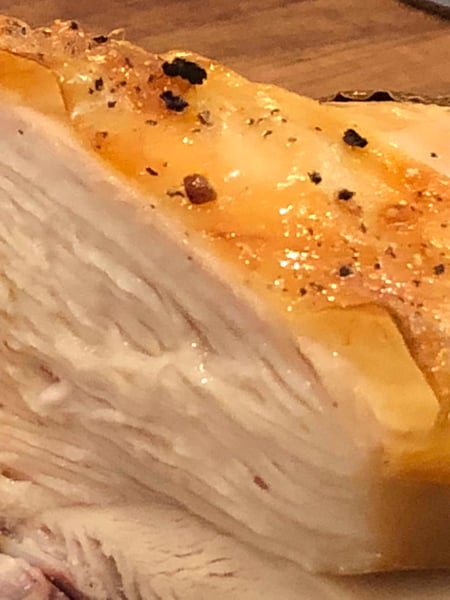
When to Brine
You can certainly brine a lot of things: meat, seafood, vegetable, even tofu. Traditionally meat and seafood are where we use brine as a simple way to add flavor to any protein. Where brine really shines is when we want to add moisture, so let’s think about what meats tend to dry out the most? Chicken breasts, yep... pork chops, yep... turkey breasts, yep. There is another problem area brine can help you out and that is meats that have been stuffed or meats cooked with the bone in. When a pork chop has a bone in it or we have stuffed it we can run into problems where the meat is over cooked on the outside and under cooked next to the bone or the stuffing. The brine allows you to cook your meat all the way through while keeping the meat moist!
Here's how to make a brine.
Basic Brine
1 Tablespoon salt
1 cup of water
Note: If you need 1 gallon of brine to cover a whole turkey or a chicken, I would just increase the above ratio by 16.
I cup salt
1 gallon water
Flavoring the Brine
To your basic brine mixture, you can add additional aromatics, spices or sugar. These aromatics would be in addition to the basic brine. If you wanted to add any aromatic liquids like bourbon, white wine or lemon juice, you would subtract the amount you added from the water. Here are a few examples of some brine recipes.
Bourbon and Bay Brine
1 Tablespoon salt
4 bay leaves
½ teaspoon black peppercorns
1 Tablespoon sugar
¾ cup water
¼ cup Bourbon
Cranberry Orange Brine
1 Tablespoon salt
Peel of 1 orange
Juice of 1/2 orange, approximately ¼ cup
5 whole allspice
¼ cup dried cranberries
¾ cup water
Fresh Herb Brine
1 Tablespoon salt
3 fresh bay leaves
4 whole fresh sage leaves
4 sprigs fresh thyme
4 borage blossoms
½ teaspoon black peppercorns
2 whole garlic cloves
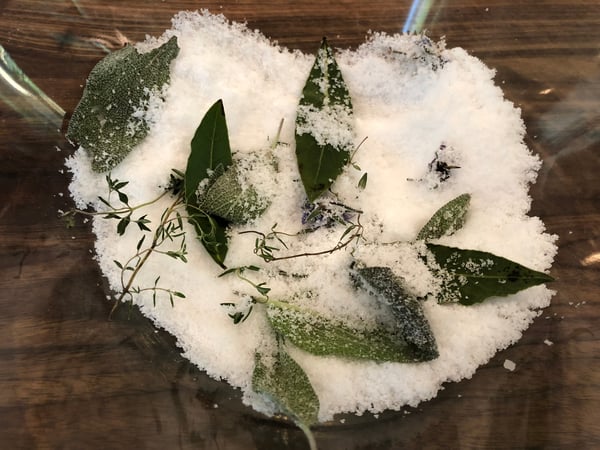
We generally need at least 2 to 4 cups of brine to completely submerge the food. To scale this recipe up or down, simply multiply by 2 or 4 as an example to get the amount of brine you need.
In preparing the brine, you will want to heat at least some of the water so it can dissolve the salt and release the aromatic qualities of the ingredients in the brine. After adding the hot water, I usually let the flavors infuse at least 10 to 15 minutes.
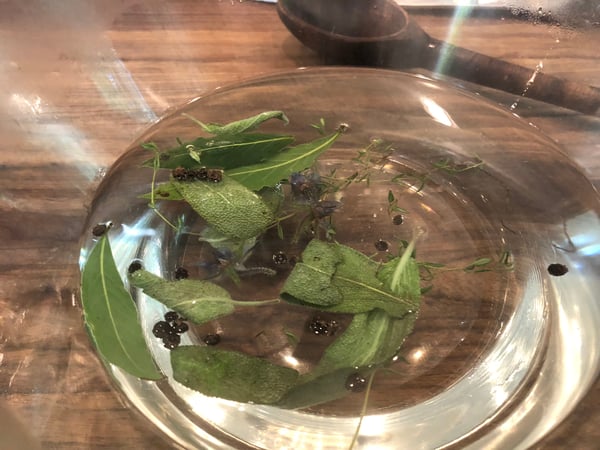
I’ve given you some examples above but play around and come up with your own flavors: onion, maple syrup, brown sugar, vanilla bean, herbs, spices of all kinds are used. The Chopping Block's Flavor Dynamics class is a perfect way to build your confidence and skills in building flavor profiles.
How long to brine
- 30 to 60 minutes for foods like shrimp, scallops, boneless skinless chicken breast or a salmon filet
- 60 to 120 minutes for foods like bone-in pork chops and chicken, pork tenderloin, ribs, whole fish
- 4 to 6 hours for foods like brisket, flank steak, pork loin
- 6 to 12 hours for foods like whole chickens, pork shoulder, lamb shank, pork belly
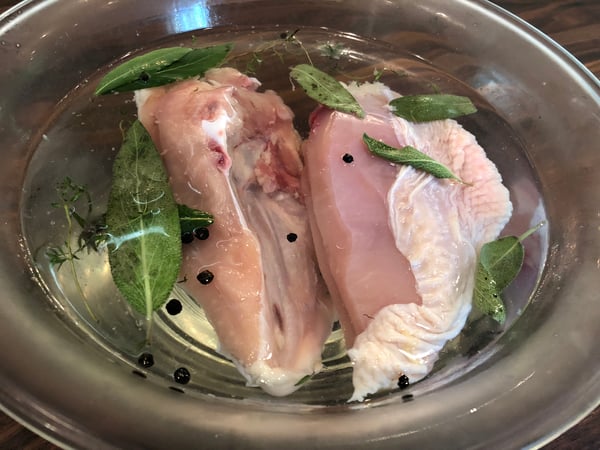
The only thing we might ever brine longer than 24 hours is a really big turkey but usually 24 hours should be sufficient for a turkey.
How to cook brined food
Our grilling classes, as well as Meat 101, Chicken 101 and Seafood 101 classes can help build your skills in meat, poultry and seafood cookery but once you have those skills you would follow your normal cooking times and temperatures. With brining you should consider a few things before you start cooking. For instance, the moisture of the brine coupled with the salt on the exterior can impede browning. Make sure to rinse the brine solution off the meat and dry it thoroughly. If you are brining something for a very long time, I actually like to dry the meat off and let it sit in the fridge uncovered for a few hours and up to 24 hours if you have the time. The fridge is generally a pretty dry environment and it helps to dry out the meat and aid in browning.
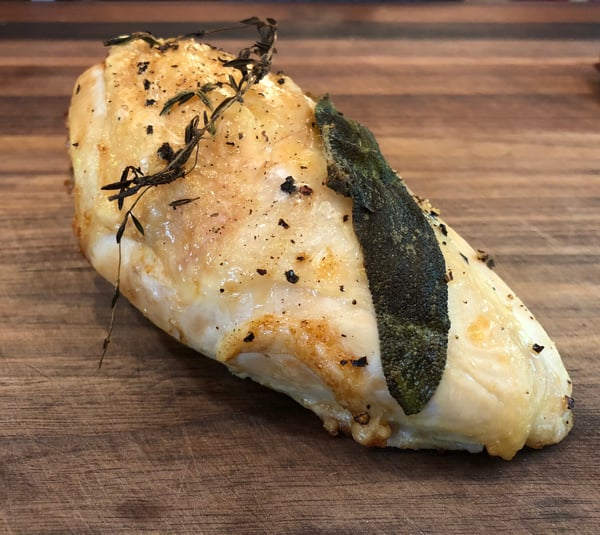
I hope this post opens up the world of brining for you! Please share your comments, questions and of course brining recipes and tips for our readers below.
If you'd like to watch a tutorial on brining, check out my video:


